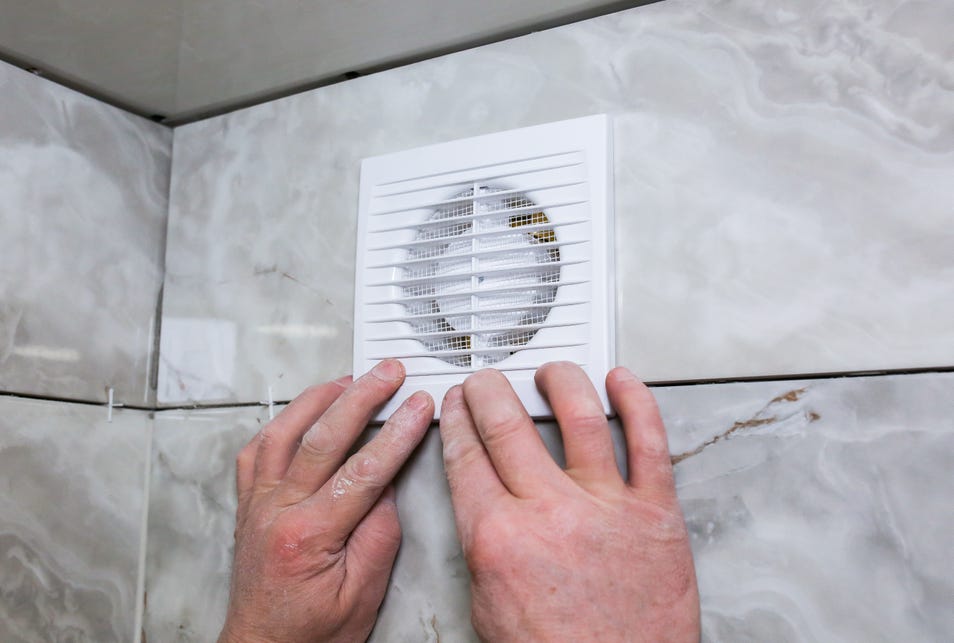How to Clean a Bathroom Exhaust Fan

The exhaust fan in your bathroom is one of the most underappreciated and overlooked parts until it starts to sound like an airplane taking off.
This essential tool silently works against mold and mildew growth and helps remove excess moisture, humidity, odors, vapors, air contaminants, and other pollutants.
It draws air into the unit and expels it through a vent to the outside. Because this process is crucial to creating a wellness oasis inside your bathroom, cleaning it more often is equally important.
Learn how to clean a bathroom fan to keep it free from dirt, dust, and debris and ensure it continuously functions optimally.
How Often to Clean a Bathroom Exhaust Fan
Bathroom exhaust fans also need regular care and maintenance like any other appliance. If you use the bathroom daily, you must thoroughly clean the exhaust fan every six months.
Use a duster with an extendable handle to remove visible dirt and dust from the exterior at least twice a week.
How to Clean Bathroom Fan
Take the following safety precautions before beginning to clean, such as:
Make sure the floors are clear of any water.
Shut off the electrical breaker for the bathroom.
Ensure the power switch for the fan is off.
Always use a sturdy ladder.
Step 1
Use a stepladder, a flashlight (if required), and a vacuum or electrostatic duster to remove the visible dust and cobwebs from the exterior of the bathroom fan.
Step 2
Most fan covers can be removed by gently pulling them away from the ceiling or wall. However, you might need to use a screwdriver to remove the cover for some models.
Step 3
After removing the cover, you’ll see the motor and blades of the unit. Most exhaust fans are plugged into an outlet, so, for safety reasons, unplug it before cleaning the blades and surrounding area.
Step 4
Mix 1.5 capfuls of Harpic Bathroom Cleaner Citrus in half a bucket of water (4 cups). Ensure to follow the dosage instructions the manufacturer lists on the product packaging.
Step 5
Submerge the vent cover in the cleaning solution you just made and let it soak to remove dirt, dust, grime, hairspray, and other contaminants while you clean the rest of the unit.
After soaking, use a microfiber cloth to clean the vent cover and rinse it in warm water. Place the cover on an absorbent towel and let it air-dry completely before reinstalling.
Step 6
Remove the fan unit from the recessed housing (if possible). Most models will come out with just a few twists. Take a sponge or microfiber, dampen it lightly with water, and wipe away the dust from the blades and motors.
If the fan can’t be removed from the housing, use a damp cloth, vacuum, or electrostatic duster to remove as much dust as possible.
Step 7
After that fan, it is time to vacuum or duster as much debris as possible from the recessed housing and brackets that hold the fan.
Step 8
Once all the components are clean, dry, and dust-free, place the fan back into the housing by screwing it in or reconnecting it to the brackets. Turn the fan blades with your fingers to ensure they are not hitting any part of the housing.
Step 9
In the final step, test your fan by turning on the bathroom electrical breaker and the fan switch. You may have to readjust the blades if you hear some clicking noise but follow the safety procedures.
FAQs
Can I clean the bathroom exhaust fan without removing it?
If the fan can’t be removed from the housing, use a damp cloth, vacuum, or electrostatic duster to remove as much dust as possible. However, for a thorough cleaning, it is recommended that you remove the cover and clean the motor and blades.
What are the signs that my bathroom exhaust fan needs cleaning?
Common signs that your bathroom exhaust fan needs cleaning include noisy operation and inadequate airflow/ventilation.
Is it necessary to turn off the power before cleaning a bathroom exhaust fan?
Before cleaning your exhaust fan, it is very important to turn off the power. You can do this by either switching off the fan button or turning off the bathroom’s circuit breaker.
.png?width=70&height=88&format=png&quality=50)